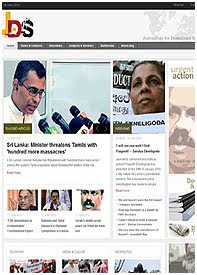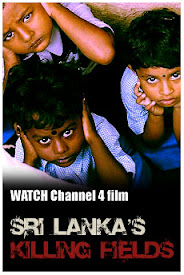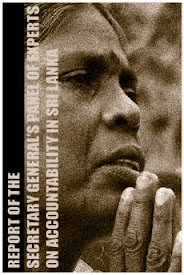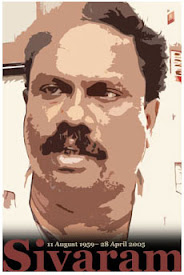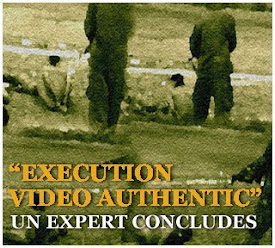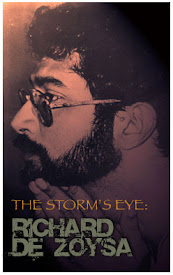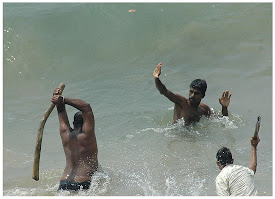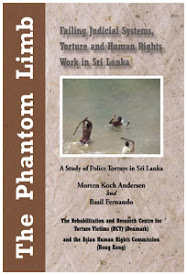
By Emil van der Poorten - As if the outpourings of the Dayan Jayatillekas and Malinda Seneviratnes don’t adequately fill the bill for “apologia” for the Rajapaksa regime’s campaign against those critical of it, an English daily with pretensions to objectivity and non partisan journalism cuts loose its Political Correspondent, with two days worth of piffle about the disappearance of Prageeth Eknaligoda wrapped in a tissue of trivia, inclusive of suggestions that Mr. Eknaligoda’s wife and Sunanda Deshapriya (another journalist) are party to some scam of significant proportions.
The exercise appears to be intended to prove that Eknaligoda has not, in fact, been “disappeared” but is hiding somewhere pending his departure to a life of leisure and luxury in some foreign clime where he will be accorded all kinds of perks by virtue of his being a “persecuted journalist from Sri Lanka seeking asylum” in some bastion of Western democracy.
The problem I have with this piece and one I will refer to later in this column is not in the matter of basic content – it is fair comment, I suppose in this country, to suggest that a journalist whose whereabouts have become a matter of public conjecture for several months is in hiding with a view to seeking political asylum in another country. However, when this is spun out and pitched in the manner this particularly laboured narrative is, then it certainly raises suspicions of an attempt to twist reality to project something that the available information does not support.
To begin at the end, let me suggest that the spinner of this tale is either supremely naive about the conditions under which refugees live or is guilty of deliberate prevarication. Western democracies do not provide a bed of roses to new arrivals at the best of times, leave alone to those arriving as refugees — I have worked with refugee and immigrant populations in Canada for a significant length of time and I would suggest that I know a bit more about this kind of stuff than the author of that piece on Eknaligoda who, in a fashion typical of Sri Lankan “experts,” has sought to impose his opinion on a readership that, by and large, doesn’t have a clue about the conditions facing refugees in places with inhospitable populations, inhospitable climates and the potential for providing significant cultural shock, among other challenges.
To suggest that any Sri Lankan journalist could walk into some kind of cossetted existence in a society alien to them and ply their trade no sooner their feet touched the ground is nothing short of unmitigated nonsense.
The author of the anti-Eknaligoda tirade is probably too young to remember the man considered by many to be the greatest political cartoonist produced by Sri Lanka, Aubrey Collette. That worthy was considered on a par with the famed David Low of, if I remember right, The New Statesman of that time. However, subsequent to his migration to Australia, Collette never achieved the eminence he had in Sri Lanka. Prageeth Eknaligoda, by any description, is (was?) no Aubrey Collette.
I would suggest that none of the journalists who have been forced to seek new residences in the English-speaking countries of the Western world, leave alone Continental Europe or the Scandinavian countries, can ever achieve anything close to the degree of acceptance of their professional skills that they had in the land of their birth. I would venture to guess that very few, if any of them even work in the journalistic professions once domiciled in the First World. To suggest otherwise is stretching credibility more than a little bit.
Very importantly, what the writer fails to indicate is that if Prageeth Eknaligoda is such a non-entity why he has devoted two whole pages of a broadsheet to a discussion of his whereabouts.
I do not believe that the value of a person’s life — and that is what we are talking about here – is dependant on his “importance.” The burden of the treatise I refer to seems to suggest otherwise and, given that fact, why does the author bother with this nonentity? The most obvious explanation is that this is an attempt at (yet another) cover-up for someone being “disappeared.”
Perhaps, this whole discussion can be brought to a conclusion by one of the plethora of state security agencies finding this man and prosecuting him for even suggesting that our simon-pure forces of law and order might have something to do with his disappearing from public view for such an inordinately long time.
The author appears to be yet another conspiracy theorist, in this case with regard to people (potentially) seeking the protection of the now-infamous “international community.” He appears to suggest that the Western democracies are waiting with bated breath for the appearance of the Eknaligodas of the Third World so that they may clasp them to their collective bosoms and accuse poor little Sri Lanka of yet another dastardly crime in the area of human rights.
All of this is absolute piffle and the dead giveaway is the author’s description of the Nirvana that awaits runaway Sri Lankan journalists.
Suffice it to say that there is no Nirvana awaiting any escapee from places like Sri Lanka in the Western world. The process of accultaration and adaptation to a new world took a lot of blood, sweat and tears even 40 years ago and is even more stressful and difficult in countries where the influx of “foreigners” is stretching their resources significantly. And I do not know of one single Sri Lankan journalist who has entered any of the so-called ‘émigré havens’ in recent times and secured employment in journalism leave alone become a significant contributor to their new country’s electronic or print media.
That they will find societies where they have the “luxury” of the rule of law prevailing and laws that preclude the worst of racial and other prejudices is, perhaps, a quantum improvement over dear old Sri Lanka, but to suggest that people who’ve plied the wordsmith’s trade in this country could walk into high-paying journalistic niches is nothing but balderdash.
No, it seems that this focusing on some minor journalist’s disappearance has been little but an exercise in exculpating the current regime from what has become the reality for anyone having the temerity to question or criticise its conduct – harassment, threat and the ultimate in penalties.
Another journalist in another English Sunday paper has recently expounded at length on the subject of what faces journalists critical of the current regime. His argument, if nothing else, is novel. It is that journalists in this country who, he freely admits, have been subjected to harassment of many kinds including being assassinated, are not too badly off because none of them, with the exception of Mr. Tissainayagam, have been prosecuted under the (draconian) emergency laws that this government continues to impose on its citizenry!
That this attempt at sophistry is applied to a matter as serious as the right to democratic dissent in a country that claims to be a democracy perhaps defies description. However, I cannot end without, at least, a passing comment:
What this journalist is saying, is that intimidation, mayhem and murder of all kinds is okay as long as those disagreeing with this government are not prosecuted under existing provisions of the law.
In conclusion, suffice it to say, that these two senior journalists have, obviously, unwittingly exposed the awful underbelly of the status quo in a manner that its critics would have found difficult even if they had been prepared to take the attendant risks that doing so would have entailed.
© The Sunday Leader
Sunday, May 23, 2010
Apologia for the persecution of journalists
Sunday, May 23, 2010
Sri Lanka: 250 acres of forest land cleared for Mullaitivu resettlement project
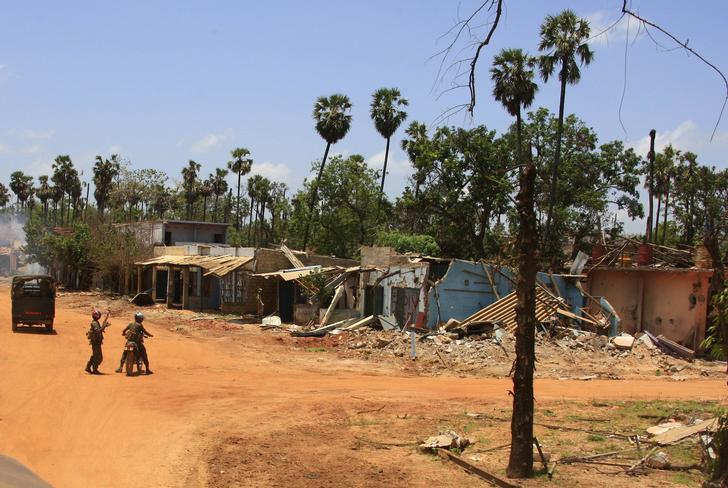
The government has sanctioned the clearing of 3,920 acres of jungle in the Mullaitivu district to make way for a large-scale resettlement programme, under the Uthuru Wasanthaya (Northern Spring) programme.
Resettlement Minister Milroy Fernando said the land had been set aside for 1,500 Mullaitivu families who were forced to leave the area because of the conflict, going back to 1985.
“The government is responding to appeals from people who fled the area and who now want to return to their original homes,” he said.
Meanwhile, the large-scale forest clearing operation is ringing alarm bells in environmental circles.
More than 250 acres of forest land have already been cleared, according to State Timber Corporation General Manager, P. G. Kumarasinghe, who says the corporation is acting on the instructions of the Mahaweli Authority.
Hundreds of valuable trees, including ebony, satinwood, teak, palu and weera, have been felled to clear land in the Halambawewa area, close to the Kokilai Lagoon.
Environmentalists say the tree-felling is illegal, pointing out that the Central Environmental Authority has not issued an Environmental Impact Assessment (EIA) on a project that requires the clearing of thousands of acres of virgin forest.
The State Timber Corporation’s Mr. Kumarasinghe, however, says the Mahaweli Authority has the power, under the Mahaweli Authority Act, to go ahead with the project. Environmentalists also say the felling of trees is being conducted in an irregular way, and that valuable timber is being sold at “firewood prices.”
Acting on a tip-off from one environmental group, the Forest Conservation Department seized five lorries transporting timber out of the area. The drivers were produced before the Kebithigollewa Magistrate and fined Rs. 10,000 each. The Magistrate has ordered the suspension of the felling of trees until investigations are completed.
Meanwhile, the Central Environmental Authority chairman Charitha Herath said the CEA has received no complaints so far about forest clearing in the North.
© The Sunday Times
Sunday, May 23, 2010
Sri Lanka: Attorney General under the president

By Kumar David - Peter the Great is widely thought to be the man who transformed Russia. Before him it was a backward landmass that Europe ignored if not despised. He dragged old Muscovy, kicking and screaming, out of barbarian medievalism into modernity and empire. He transformed country and culture, industry and army; in popular imagery he created the Empire and is Russia’s greatest emperor. When cruel winter ensnared powerful Sweden’s greatest soldier, Charles XII, Peter scorched the earth, and nature and Emperor conspired to defeat Charles’ invading army in 1709 at Poltava.
Europe had to wake up; a new great power had arrived. The Chinese are arriving differently, by exporting containers jammed chockfull of durables and inviting the whole world to come ogle the 2010 Shanghai Expo!
However, there is another side to Peter which is less known; he was a man of energy and drive, but also ruthless determination and cruelty. Did you know that he had his son, heir to the throne the Tsarevich Alexis, lashed with a whip that cut flesh to the bone, on charges of treachery? Alexis died a prisoner in his father’s fortress in 1718; and more strangely, did you know that Peter himself acted as prosecutor and judge at that trial? In modern times this is like placing the Attorney General’s Department directly under the President! Three hundred years ago absolute monarchies were indeed absolute, but we are said to have moved on a bit, are we not? Well, clearly not when an electorate bestows absolute power on incumbents.
The Executive Prosecutor
There has been a report in a local newspaper that moves are afoot to move the Attorney General’s Department under the president, the Asian Human Rights Commission (AHRC), an organisation for which I have much respect, issued a statement describing the prospect as a further attack on the rule of law. The crux of the AHRC’s position is as follows:
“Since 1978 the institution of the Attorney General’s Department has been subjected to serious undermining. This has been documented by observers and human rights organisations in considerable detail. However, despite of this undermining the institution has remained an independent entity and to a greater degree the officers of the institution have tried to maintain the old traditions which go back to about 125 years. The previous attempts to undermine the institution have seriously damaged its credibility and particularly the office of the Attorney General himself has lost public confidence. However, this new move will damage the institution substantially and above all it will damage the image of the institution as it will be seen as one directly controlled by the executive president.
For reasons of presentation the AHRC has, rhetorically, retained the fiction of an AG whose portfolio “remained an independent entity”, but no honest observer familiar with its track record from Brace Girdle, the disenfranchisement of plantation Tamil workers, to the Sarath Fonseka sham, will buy that fiction. That however is not the punch line of the AHRC statement which is that the takeover will one more nail in the coffin; one more step on the road to consolidation of despotic government in the Island.
If and when the president takes over the AG’s Department expect the following.
(a) The prosecution of crooks loyal to the president and the regime will cease; today’s charade will become tomorrow’s norm.
(b) AG’s advice to the executive on constitutional matters will become an “insider trading” sham; the AG will be instructed what advice to tender.
(c) Pardons, withdrawal of cases and such like will become presidential political gambits; miscreants from drug peddlers to politically useful villain will get away unscathed.
I do not take offence at readers who yawn at these comments. It is now the norm and the usual rejoinder is “face the facts, this is reality, accept and live with it, there is nothing you can do about; this is modern Sri Lanka and if the regime wants to screw you, as did Peter the Great the Tsarevich Alexis, nobody will lift a finger.” Thanks to the overwhelming mandate bestowed by the people on the regime, the only force that could have pushed back dictatorship, the people, has instead been co-opted into service.
The tip of the iceberg
Shoving the AG’s Department into the presidential toolkit is only the start; the real deal is the constitutional sham on its way. True enough the current crop of pro-government left leaders are intellectual lightweights lacking the gravitas of the NM generation, but at one time even they did bawl their heads off about the “dictatorial JR Constitution”. Now they unabashedly cheer the extension of constitutional bonapartism to naked authoritarianism. And what’s on this menu? The Thirteenth Amendment will stay in limbo (no police or land powers) though what terminology will be agreed with the Indians so that the latter can continue to pretend that they are being hoodwinked remains to be seen. Tissa Vitharana’s APRC Reports will remain at the bottom of the presidential wastepaper basket.
The main course on the menu is a third term for Rajapaska, or the complete removal of term limits through the device of an executive prime minister. The Seventeenth Amendment will be castrated to turn elections, police and other commissions into name boards. What’s wrong with removal of term limits you may ask; if the people have confidence and desire to re-elect him, so be it you may say.
Mark my words, as sure as night follows day, once term limits are removed the next and subsequent elections will be shams, frauds, fixes; that’s how the system will work. We are headed for Gotterdammerung, the Twilight of the Gods. Those rigged elections in six years time will make Marcos blush like a Mother Theresa! With the death of democracy, maybe some day people will have to pursue those other ways in which illegitimate governments are removed. Maybe, but for now, weep not for the people; their mandate was the executioner’s certificate.
© Lakbima News
Sunday, May 23, 2010
Sri Lanka: As flood waters recede, threat of diseases looms

By Nadia Fazlulhaq - Health officials warned yesterday of an outbreak of infectious and water-borne diseases in the coming days as water levels started receding in the Gampaha, Colombo and Kalutara districts. The warning came as the death toll in floods was placed at 20 while the number of people affected was around 600,000.
The Health Ministry’s Consultant Epidemiologist Anura Jayasinghe said typhoid, hepatitis A, diarrhoea, dysentery, cholera, chickenpox, viral flu, rabies, dengue and rat fever (Leptospirosis) were among the diseases that could hit the people in the aftermath of the floods.
According to him an increase in food-and-water-borne diseases especially through contaminated water is common during flood situations. Fever, fatigue, headache, constipation or diarrhoea, red spots on the chest, frequent passing of faeces with blood and/or mucus, abdominal pain, nausea, weight loss, jaundice and depression are some of the main symptoms of the common diseases. Those who are suffering from such symptoms should seek medication.
“Due to flooding, garbage pollutes fresh water sources, making them contaminated. Wells, lakes and streams are highly vulnerable. We can’t totally rely on direct pipe-borne water as the chlorinating process would have been affected due to frequent interruption of electricity,” he said.
Dr. Jayasinghe said boiled and cool water should be used for drinking purposes especially for children. He said that an increase in mosquito breeding might take place after the floods receded as containers that held water would be ideal breeding sites for mosquitoes.
Dr. A. Balasooriya, consultant community physician attached to the Health Education Bureau, said green leaves should not be eaten during these days as they might be contaminated and the people should be conscious of cleanliness aspects when buying meals from outside.
He said that leptospirosis (rat fever) could be transmitted by many animals including rats. The people should be watchful while travelling in flood hit areas as there was an increase in snake bite cases.
The Western Province was the worst affected by the torrential rains that continued for more than a week with Gampaha district having the highest number of displaced people.
Gampaha District Secretary J.J. Ratnasiri said that although the rain had eased, the flood waters were receding only at a slow pace in some of the worst affected areas such as Kelaniya, Mahara, Ja-ela and Katana. He said cooked meals were being distributed in 46 camps for the displaced people.
According to the Disaster Management Centre National Coordinator, Pradeep Kodipilli, 20 deaths were reported and a total of 606,072 persons or 141,586 families were affected by the floods.
“Around 466 houses were fully damaged due to floods, eartslips and gusty winds while 1,943 houses were partially damaged mainly in Galle, Gampaha and Kalutara. There are 14,634 persons in 69 IDP camps in Gampaha, Colombo, Kalutara, Puttlam, Ratnapura, Galle and Matara. Among them 9,925 are from Gampaha”, he said.
In Gampaha district, Divulapitiya, Attanagalle, Biyagama, Ja-ela, Dompe, Gampaha, Wattala, Minuwangoda, Negombo, Mahara, Katana, Kelaniya were the worst affected areas.
In Colombo district areas in the Colombo city, Kollonnawa, Moratuwa, Kesbewa, Piliyandala, Kotte, Rajagiriya, Padukka, Homagama, Ratmalana, Dehiwala, Maharagama, Seethawaka and Kaduwela went under water.
In the Kalutara District, Horana, Bandaragama, Matugama and Palinda Nuwara were the worst affected with several instances of landslides.
A senior official of the Meteorology Department attributed the floods to the pre-monsoon conditions, atmospheric disturbances in the Bay of Bengal, effects of cyclone Laila and the establishing of the South West monsoon.
30 snake bites
At least 30 people including children were admitted to hospital after being bitten by snakes in flood-hit areas, mainly in the Gampaha district, hospital officials said.
Most of the victims were bitten when they re-entered their homes to collect essential belongings, Dr. Teja Perera of the Ragama hospital said adding that most of the victims were bitten by cobras and russell’s vipers. Dr. Perera said none of the victims was in a life-threatening condition as they were treated in time.
© The Sunday Times
This site is best viewed with firefox

Search
Is this evidence of 'war crimes' in Sri Lanka?
Archive
- ▼ 2010 (1312)
- ► 2011 (687)
Links
- Reporters Sans Frontières
- Media Legal Defence Initiative
- International Press Institute
- International News Safety Institute
- International Media Support
- International Freedom of Expression eXchange
- International Federation of Journalists
- Committee to Protect Journalists
- Asian Human Rights Commission
- Amnesty International
![Reblog this post [with Zemanta]](http://img.zemanta.com/reblog_e.png?x-id=9c6c527d-574c-49a8-83f6-d86525d5cd9b)
![Reblog this post [with Zemanta]](http://img.zemanta.com/reblog_e.png?x-id=6a265962-96a7-47ab-9a1d-0acd1d1745a0)
![Reblog this post [with Zemanta]](http://img.zemanta.com/reblog_e.png?x-id=200f8b44-b4cb-4200-9aa2-a22ac6f61c0f)
![Reblog this post [with Zemanta]](http://img.zemanta.com/reblog_e.png?x-id=8634da07-c557-43b4-82ad-bf9309fe817c)
